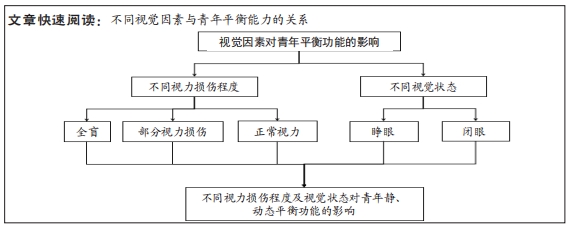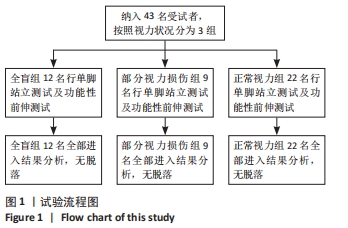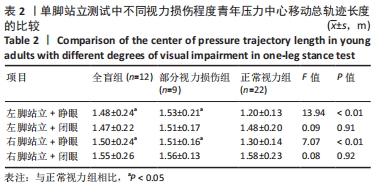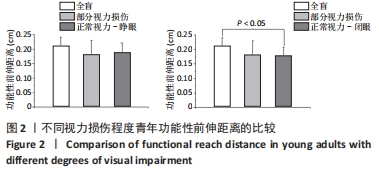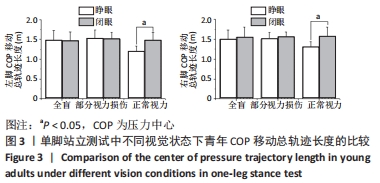[1] WHO. International Classification of Diseases, 11th Revision (ICD-11). [2019-06-29]. https://www. who.int/classifications/icd/en/.
[2] RUSSO MM, LEMOS T, IMBIRIBA LA, et al. Beyond deficit or compensation: new insights on postural control after long-term total visual loss. Exp Brain Res. 2016; 235(2):437-446.
[3] MIHAILOVIC A, DE LUNA RM, WEST SK, et al. Gait and Balance as Predictors and/or Mediators of Falls in Glaucoma. Invest Ophthalmol Vis Sci. 2020; 61:30.
[4] WHO. World report on vision. [2019-10-08]. https://appswhoint/iris/bitstream/handle/10665/328717/9789241516570-engpdf.
[5] CHENG CY, WANG N, WONG TY, et al. Prevalence and causes of vision loss in East Asia in 2015: magnitude, temporal trends and projections. Br J Ophthalmol. 2020; 104(5):616-622.
[6] GBD 2019 Blindness and Vision Impairment Collaborators; Vision Loss Expert Group of the Global Burden of Disease Study. Causes of blindness and vision impairment in 2020 and trends over 30 years, and prevalence of avoidable blindness in relation to VISION 2020: the Right to Sight: an analysis for the Global Burden of Disease Study. Lancet Glob Health. 2021;9(2):e144-e160.
[7] SADOWSKA D, STEMPLEWSKI R, SZEKLICKI R. Postural Control in Young People with Visual Impairments and Various Risks of Falls. J Visual Impair Blin. 2017; 111(3):261-270.
[8] EHRLICH JR, HASSAN SE, STAGG BC. Prevalence of Falls and Fall-Related Outcomes in Older Adults with Self-Reported Vision Impairment. J Am Geriatr Soc. 2019;67: 239-245.
[9] HOPEWELL S, ADEDIRE O, COPSEY BJ, et al. Multifactorial and multiple component interventions for preventing falls in older people living in the community. Cochrane Database Syst Rev. 2018;7(7):CD012221.
[10] METHA J, CZANNER G, HARDING S, et al. Visual risk factors for falls in older adults: a case-control study. BMC Geriatr. 2022;22(1):134.
[11] CHEN EW, FU AS, CHAN KM, et al. Balance control in very old adults with and without visual impairment. Eur J Appl Physiol. 2012;112(5):1631-1636.
[12] FUJIO K, TAKEUCHI Y. Discrimination of standing postures between young and elderly people based on center of pressure. Sci Rep. 2021;11(1):195.
[13] CAI JM, YE Y, LIANG P, et al. Frequency of presenting visual acuity and visual impairment in Chinese college students. Int J Ophthalmol. 2020;13(12):1990-1997.
[14] XU T, WANG B, LIU H, et al. Prevalence and causes of vision loss in China from 1990 to 2019: findings from the Global Burden of Disease Study 2019. Lancet Public Health. 2020;5(12):e682-e691.
[15] JETER PE, NKODO AF, MOONAZ SH, et al. A systematic review of yoga for balance in a healthy population. J Altern Complement Med. 2014;20(4):221-232.
[16] CHEN B, LIU P, XIAO F, et al. Review of the Upright Balance Assessment Based on the Force Plate. Int J Environ Res Public Health. 2021;18(5):2696.
[17] RUTKOWSKA I, BEDNARCZUK G, MOLIK B, et al. Balance Functional Assessment in People with Visual Impairment. J Hum Kinet. 2015;48:99-109.
[18] SOBRY V, BADIN P, CERNAIANU S, et al. Do visually impaired people have a static balance as effective as sighted people? Neuro Rehabil. 2014;35:851-861.
[19] ALGHADIR AH, ALOTAIBI AZ, IQBAL ZA. Postural stability in people with visual impairment. Brain Behav. 2019;9(11):e01436.
[20] 高天宇,张孝权,宿旺,等. 视觉剥夺前后老年人单足站立平衡特征研究[J].中国康复医学杂志,2020,35(4):427-433.
[21] BOHANNON RW, MYERS BJ, TUDINI FT, et al. Kinematics of shoulder, trunk, pelvis, and hip while reaching forward to progressively distant targets. J Bodyw Mov Ther. 2020;24(3):221-226.
[22] SHARIF BIDABADI S, MURRAY I, LEE GYF. Validation of foot pitch angle estimation using inertial measurement unit against marker-based optical 3D motion capture system. Biomed Eng Lett. 2018;8(3):283-290.
[23] 朱晓敏,刘元旻,杜雪晶,等.功能性伸展测试临床应用进展[J]. 中国康复理论与实践,2021,27(5):583-587.
[24] PIERCE CB, MUNOZ A, NG DK, et al. Age- and sex-dependent clinical equations to estimate glomerular filtration rates in children and young adults with chronic kidney disease. Kidney Int. 2021;99(4):948-956.
[25] YAMAGATA M, IKEZOE T, KAMIYA M, et al. Correlation between movement complexity during static standing and balance function in institutionalized older adults. Clin Interv Aging. 2017;12:499-503.
[26] TANEDA K, MANI H, KATO N, et al. Effects of simulated peripheral visual field loss on the static postural control in young healthy adults. Gait Posture. 2021;86:233-239.
[27] HOOD J, SHARRAH ML. Functional Reach and Gait Speed Improvement in A Matter of Balance Participants. J Trauma Nurs. 2022;29(1):5-11.
[28] THOMAS J, O’NEAL S. Relationship of Functional Reach Test scores and falls in Special Olympics athletes. J Intellect Disabil Res. 2019;63(6):587-592.
[29] MARANESI E, GHETTI G, RABINI RA, et al. Functional reach test: movement strategies in diabetic subjects. Gait Posture. 2014;39(1):501-505.
[30] 陈泽华,叶翔凌,陈伟健,等. 健康成年人下肢本体感觉与姿势稳定性的关系[J]. 中国组织工程研究,2020,24(29):4692-4696.
[31] 欧阳一毅,彭杰,王坤,等. 儿童下肢生物力学特征在视觉剥夺及双重任务时的变化[J]. 中国组织工程研究,2022,26(12):1834-1842.
[32] GRACE GAERLAN M, ALPERT PT, CROSS C, et al. Postural balance in young adults: the role of visual, vestibular and somatosensory systems. J Am Acad Nurse Pract. 2012; 24:375-381.
[33] ZETTERLUND C, LUNDQVIST LO, RICHTER HO. Visual, musculoskeletal and balance symptoms in individuals with visual impairment. Clin Exp Optom. 2019;102:63-69.
[34] ZIPORI AB, COLPA L, WONG AMF, et al. Postural stability and visual impairment: Assessing balance in children with strabismus and amblyopia. PLoS One. 2018; 13(10):e0205857.
[35] GAZZELLINI S, LISPI ML, CASTELLI E, et al. The impact of vision on the dynamic characteristics of the gait: strategies in children with blindness. Exp Brain Res. 2016;234(9):2619-2627.
[36] BEDNARCZUK G, WISZOMIRSKA I, RUTKOWSKA I, et al. Role of vision in static balance in persons with and without visual impairments. Eur J Phys Rehabil Med. 2021;57(4):593-599.
[37] PARREIRA RB, GRECCO LAC, OLIVEIRA CS. Postural control in blind individuals: A systematic review. Gait Posture. 2017;57:161-167.
[38] PIRÔPO US, DOS SANTOS ROCHA JA, PASSOS RDS, et al. Influence of visual information in postural control: Impact of the used stabilometric analysis methods. Eur J Hum Movement. 2016;37:21-29.
[39] ROGGE AK, HAMACHER D, CAPPAGLI G, et al. Balance, gait, and navigation performance are related to physical exercise in blind and visually impaired children and adolescents. Exp Brain Res. 2021; 239(4):1111-1123.
[40] SLAVOLJUB U, GORAN Z, RADMILA K, et al. Comparison of the static balance of children with and without visual impairment. Res in Phys Educ, Sport and Health. 2015;4:95-99.
[41] TOMOMITSU MS, ALONSO AC, MORIMOTO E, et al. Static and dynamic postural control in low-vision and normal-vision adults. Clinics. 2013;68:517-521.
|
